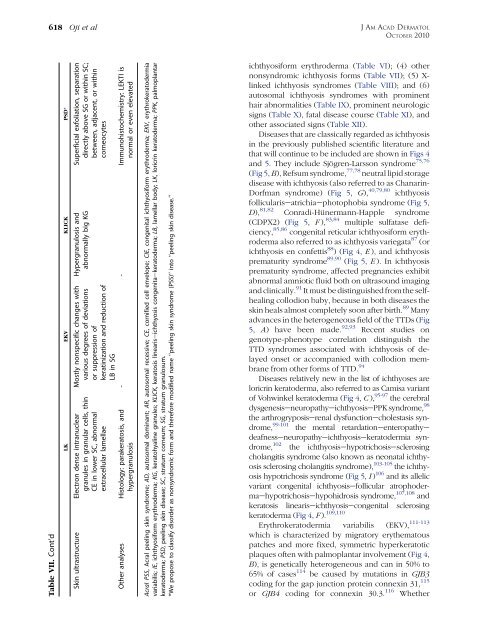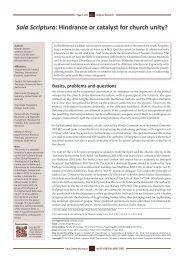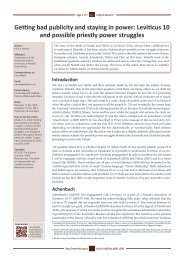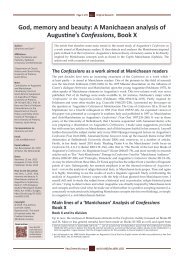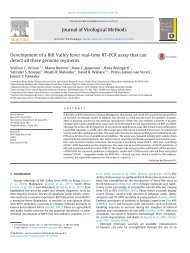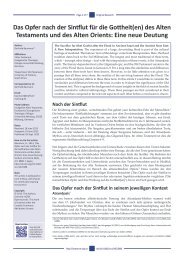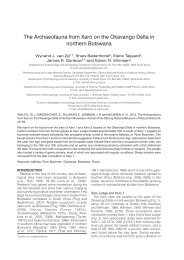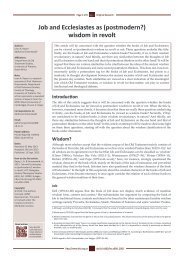Revised nomenclature and classification of inherited ichthyoses ...
Revised nomenclature and classification of inherited ichthyoses ...
Revised nomenclature and classification of inherited ichthyoses ...
You also want an ePaper? Increase the reach of your titles
YUMPU automatically turns print PDFs into web optimized ePapers that Google loves.
618 Oji et al<br />
Table VII. Cont’d<br />
LK EKV KLICK PSD*<br />
Mostly nonspecific changes with Hypergranulosis <strong>and</strong><br />
Superficial exfoliation, separation<br />
various degrees <strong>of</strong> deviations abnormally big KG<br />
directly above SG or within SC;<br />
or suppression <strong>of</strong><br />
between, adjacent, or within<br />
keratinization <strong>and</strong> reduction <strong>of</strong><br />
corneocytes<br />
LB in SG<br />
- - Immunohistochemistry: LEKTI is<br />
normal or even elevated<br />
Skin ultrastructure Electron dense intranuclear<br />
granules in granular cells, thin<br />
CE in lower SC, abnormal<br />
extracellular lamellae<br />
Other analyses Histology: parakeratosis, <strong>and</strong><br />
hypergranulosis<br />
Acral PSS, Acral peeling skin syndrome; AD, autosomal dominant; AR, autosomal recessive; CE, cornified cell envelope; CIE, congenital ichthyosiform erythroderma; EKV, erythrokeratodermia<br />
variabilis; IE, ichthyosiform erythroderma; KG, keratohyaline granules; KLICK, keratosis lineariseichthyosis congenitaekeratoderma; LB, lamellar body; LK, loricrin keratoderma; PPK, palmoplantar<br />
keratoderma; PSD, peeling skin disease; SC, stratum corneum; SG, stratum granulosum.<br />
*We propose to classify disorder as nonsyndromic form <strong>and</strong> therefore modified name ‘‘peeling skin syndrome (PSS)’’ into ‘‘peeling skin disease.’’<br />
ichthyosiform erythroderma (Table VI); (4) other<br />
nonsyndromic ichthyosis forms (Table VII); (5) Xlinked<br />
ichthyosis syndromes (Table VIII); <strong>and</strong> (6)<br />
autosomal ichthyosis syndromes with prominent<br />
hair abnormalities (Table IX), prominent neurologic<br />
signs (Table X), fatal disease course (Table XI), <strong>and</strong><br />
other associated signs (Table XII).<br />
Diseases that are classically regarded as ichthyosis<br />
in the previously published scientific literature <strong>and</strong><br />
that will continue to be included are shown in Figs 4<br />
<strong>and</strong> 5. They include Sjögren-Larsson syndrome 75,76<br />
(Fig 5, B), Refsum syndrome, 77,78 neutral lipid storage<br />
disease with ichthyosis (also referred to as Chanarin-<br />
Dorfman syndrome) (Fig 5, G), 40,79,80 ichthyosis<br />
folliculariseatrichiaephotophobia syndrome (Fig 5,<br />
D), 81,82<br />
Conradi-Hünermann-Happle syndrome<br />
(CDPX2) (Fig 5, F ), 83,84 multiple sulfatase deficiency,<br />
85,86 congenital reticular ichthyosiform erythroderma<br />
also referred to as ichthyosis variegata 87 (or<br />
ichthyosis en confettis 88 )(Fig 4, E ), <strong>and</strong> ichthyosis<br />
prematurity syndrome 89,90 (Fig 5, E ). In ichthyosis<br />
prematurity syndrome, affected pregnancies exhibit<br />
abnormal amniotic fluid both on ultrasound imaging<br />
<strong>and</strong> clinically. 91 It must be distinguished from the selfhealing<br />
collodion baby, because in both diseases the<br />
skin heals almost completely soon after birth. 89 Many<br />
advances in the heterogeneous field <strong>of</strong> the TTDs (Fig<br />
5, A) have been made. 92,93 Recent studies on<br />
genotype-phenotype correlation distinguish the<br />
TTD syndromes associated with ichthyosis <strong>of</strong> delayed<br />
onset or accompanied with collodion membrane<br />
from other forms <strong>of</strong> TTD. 94<br />
Diseases relatively new in the list <strong>of</strong> <strong>ichthyoses</strong> are<br />
loricrin keratoderma, also referred to as Camisa variant<br />
<strong>of</strong> Vohwinkel keratoderma (Fig 4, C ), 95-97 the cerebral<br />
dysgenesiseneuropathyeichthyosisePPK syndrome, 98<br />
the arthrogryposiserenal dysfunctionecholestasis syndrome,<br />
99-101<br />
the mental retardationeenteropathye<br />
deafnesseneuropathyeichthyosisekeratodermia syn-<br />
drome, 102<br />
JAM ACAD DERMATOL<br />
OCTOBER 2010<br />
the ichthyosisehypotrichosisesclerosing<br />
cholangitis syndrome (also known as neonatal ichthyosis<br />
sclerosing cholangitis syndrome), 103-105 the ichthyosis<br />
hypotrichosis syndrome (Fig 5, I ) 106 <strong>and</strong> its allelic<br />
variant congenital ichthyosisefollicular atrophodermaehypotrichosisehypohidrosis<br />
syndrome, 107,108 <strong>and</strong><br />
keratosis lineariseichthyosisecongenital sclerosing<br />
keratoderma (Fig 4, F ). 109,110<br />
Erythrokeratodermia variabilis (EKV), 111-113<br />
which is characterized by migratory erythematous<br />
patches <strong>and</strong> more fixed, symmetric hyperkeratotic<br />
plaques <strong>of</strong>ten with palmoplantar involvement (Fig 4,<br />
B), is genetically heterogeneous <strong>and</strong> can in 50% to<br />
65% <strong>of</strong> cases 114 be caused by mutations in GJB3<br />
coding for the gap junction protein connexin 31, 115<br />
or GJB4 coding for connexin 30.3. 116 Whether


